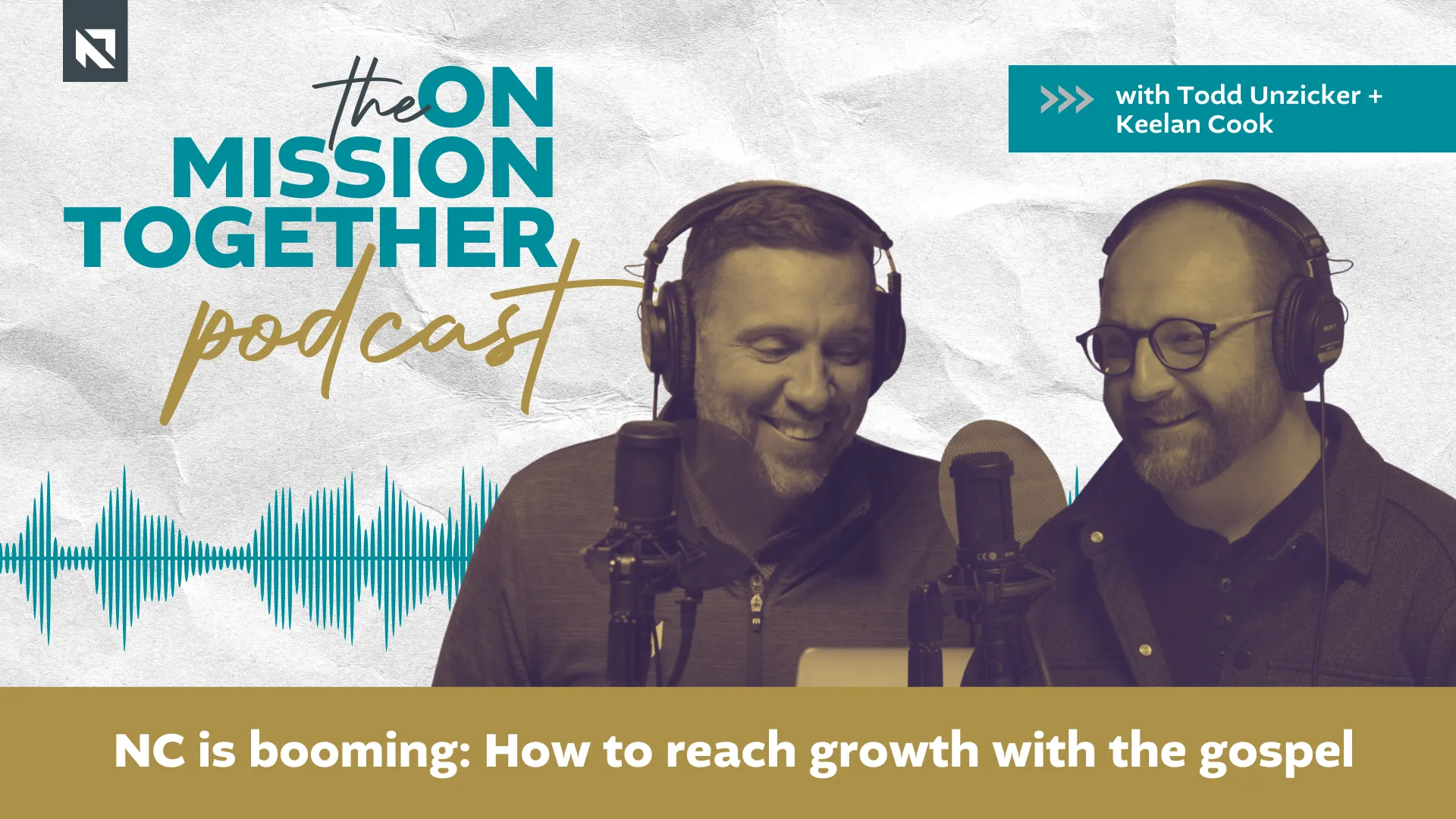A couple of months ago, I made the mistake of posting an off-handed comment on Facebook. The next thing I knew, I was in meetings with some folk from our state convention in North Carolina talking missions strategy about that off-handed comment.
Here is the gist of it: North Carolina is getting older and more diverse, and that matters for the Great Commission.
And the more I’ve looked into this demography shift, the more I realize it really matters for the sake of the Great Commission.
Shifting Demographics
North Carolina is a rapidly growing state. If you’re local to the state, that’s likely no surprise to you, but for the uninitiated, it’s one of the faster growing regions in the United States.
Estimates from Carolina Demography project a population over 12 million by 2035. That’s a far cry from where the state was a couple of decades ago.
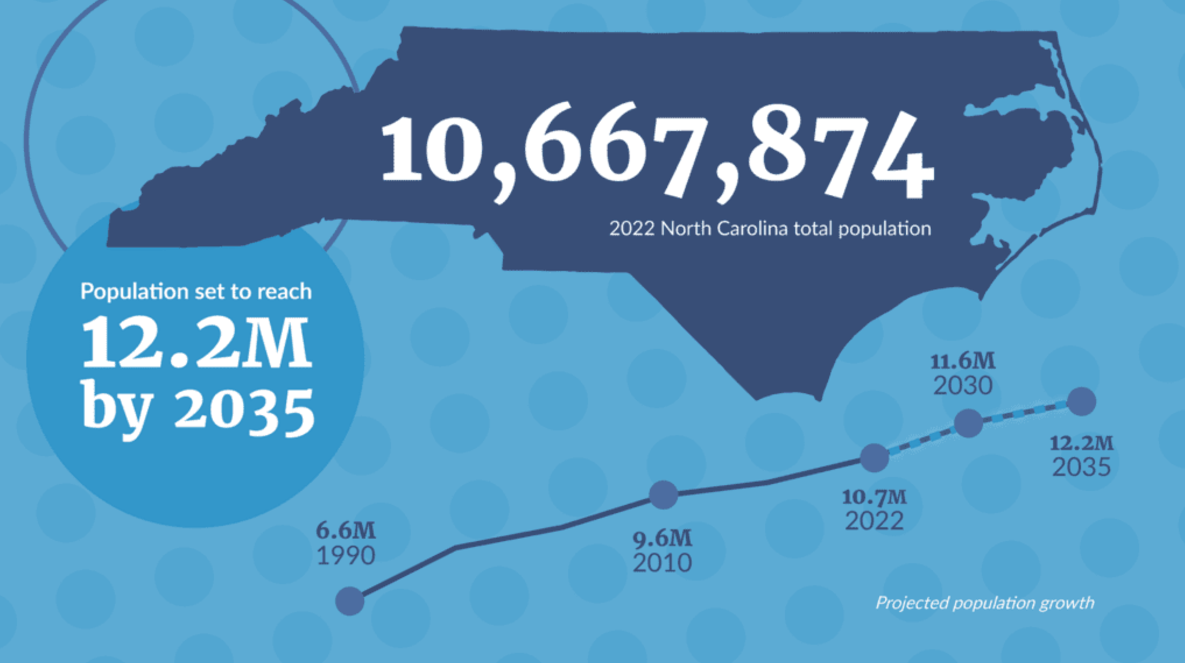
Of course, North Carolina is home to several trendy areas for young professionals. Charlotte and Raleigh are both epicenters for job creation right now. So, it’s a common assumption by many that our growth is fueled by college-age or young professionals streaming into the area hoping for their big break.
And that is happening, but it’s not actually the biggest contributor to population growth in these metros, especially the Raleigh metro that I call home.
So, what is our biggest demographic of incoming residents? Retirement age adults.
Yep, you read that right. Look at some graphs with me.
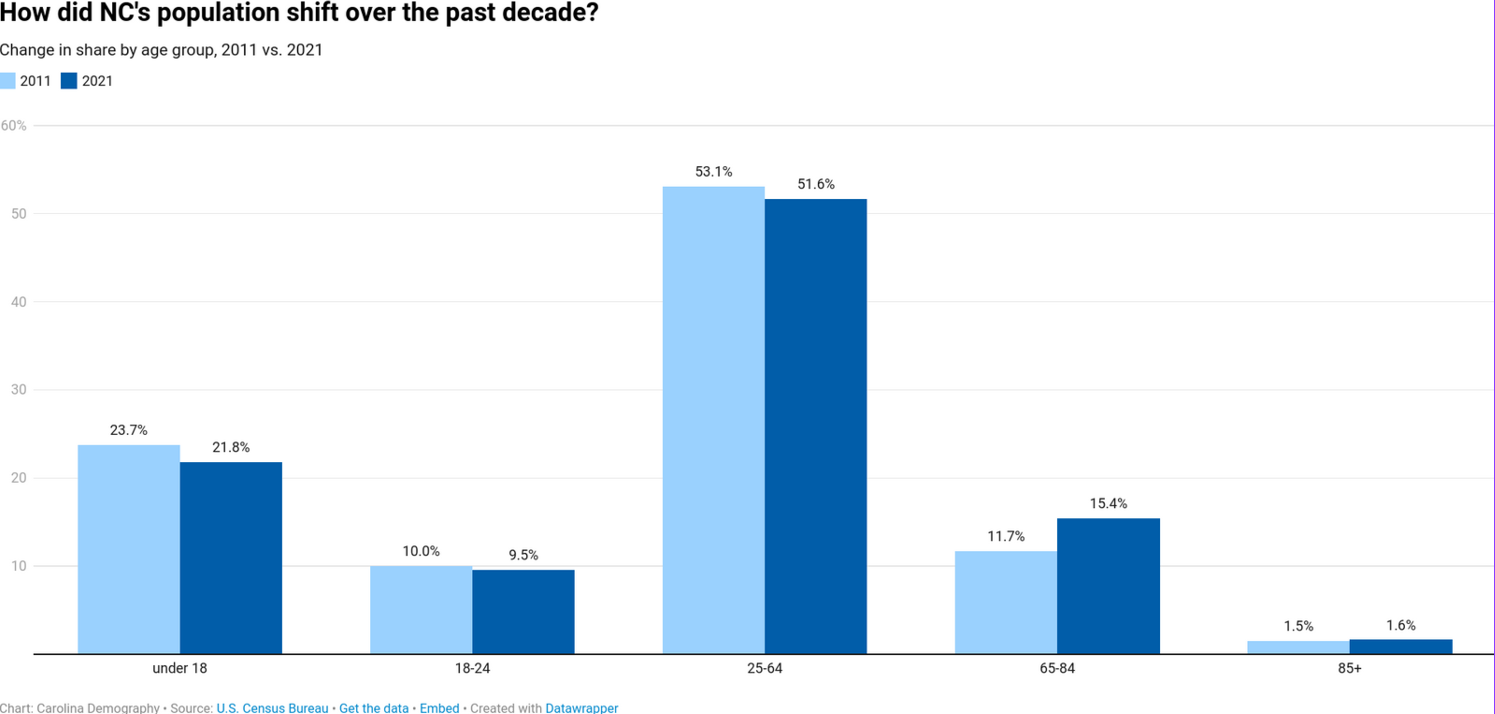
The light blue bars are the percentage population in NC in 2011 by age group. The dark blue bars are 2021. Notice that all categories are going down, except the last two. The percentage of the population that is over 65 has increased, while all other categories have declined in overall share.
The next graph makes the point even more explicit.
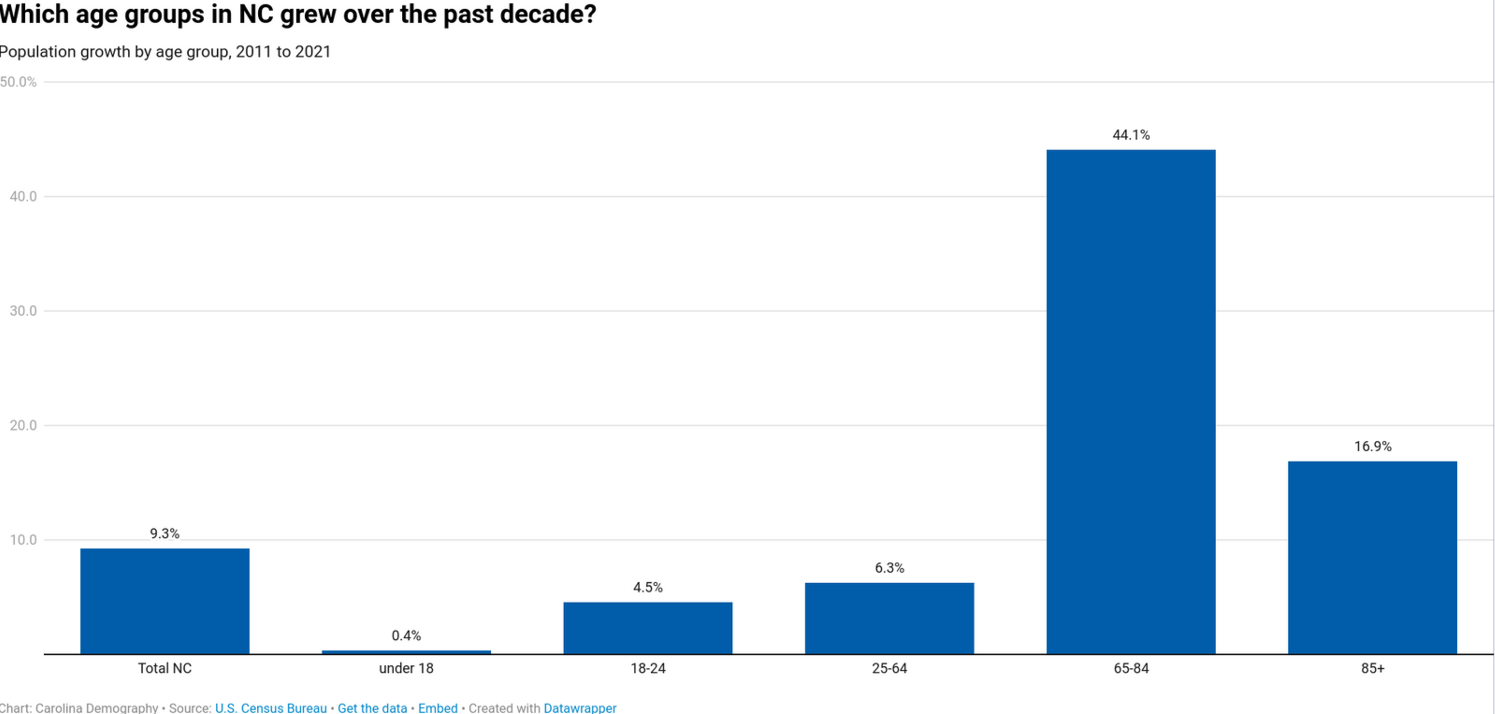
The above graph demonstrates which age groups have grown in North Carolina over the past decade. See those last two age groups. That is massive increase.
In fact, this last graph shows us the reality of the situation.

Take a look at the map above. You’d be tempted to misread this data by assuming the dark blue counties are the ones seeing growth in the post-retirement age group. However, any county shaded blue experienced a growth of at least five percent in that age range.
That’s every single county. Every county in North Carolina saw a marked increase in people over the age of 65.
What about those dark blue counties? Those saw an increase of up to fifty percent. That’s insane population shifts.
The aging of our population in North Carolina is actually a broader trend across the United States. It’s not just happening in North Carolina, but it’s especially happening in North Carolina.
Let me explain why.
There are two primary drivers of a age shift in population like this. This first is the most obvious, and what is happening across the United States. People are living longer, and young people are having less children. That means more people stick around at the top end of the age groups and less people wind up in the bottom side of the age groups. That ages a population over time.
However, North Carolina is experiencing growth for another reason: inmigration.
While all areas are seeing the aging shift mentioned above, some areas are also magnets for people moving from other areas. This has long been the case for North Carolina’s metro areas. However, the assumption is that this immigration is a bunch of young professionals looking for that big career move.
But our largest population swell is coming not from young professionals moving into hipster neighborhoods in downtown (or suburban facsimilies of these). Instead, it’s retirement-age families moving down from the Northeastern United States, not quite to Florida.
Raleigh proves the case. In July of this year, Axios reported that the Triangle is one of the country’s hottest spots for retirees since the pandemic. The article highlights the unprecedented growth in post-retirement population in the Raleigh metro (+18.3%), but notes that this trend is occurring in several major metros across the country like Austin (+17.3) and Houston (+15.3%).
Below is a graph from that Axios article about retirement-age inmigration to Raleigh.
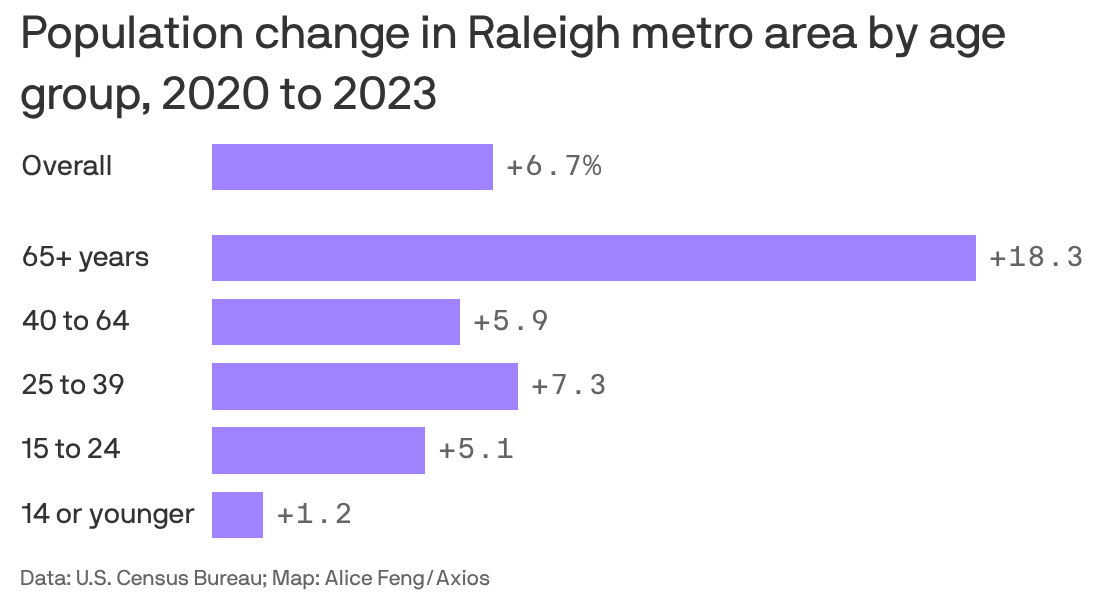
That is explosive growth in the 65+ population. And you can see it, too. Right next to my neighborhood is a new subdivision with at least 250 homes. Ironically enough, it is an age-gated community. You cannot move into the neighborhood unless you are over 55.
The Great Commission in an Aging Community
Now, if you’re a pastor, ministry leader, or someone just interested in the Great Commission, that bit of news means something for local church ministry and missions.
So many of our efforts in church planting and ministry outreach generally are aimed at young families. Everyone knows the secret to a successful church plant is a rocking kids ministry, right?
Well, what happens when the average age of your new neighbors in that recent subdivision is closer to 65 than 25?
I’ve been thinking about this ever since I saw that Axios article, and there are at least two shifts we need to make concerning the Great Commission in an aging community.
Reframe Assumptions Concerning an Aging Population
Ministering to a retirement-age population does not only mean taking care of people who can no longer take care of themselves. Many do face increasing challenges, both physically and financially, as they reach retirement-age. This creates both a responsibility and opportunity the church can meet.
However, a growing number of people over the age of 65 are in decent health and have some financial means. Many of them are considering a “second career,” or what it means to have 10-15 years left in front of them to fill. Retirement is a natural chapter change in life, but it doesn’t mean a change to convalescence for many.
Ironically enough, this may mean an increasing number of people aging out of the workforce are at the same spot, at least in some ways, as those exiting college and getting ready to enter the workforce. They have a new chapter in front of them, and they are looking for ways to use that time.
If that’s true, it means we need to adjust our aim in a lot of our missional efforts.
Reframe Missional Engagement to Consider Those at Retirement Age
Most churches think of missional engagement as something we do among younger population segments, but we must consider retirement-age segments as a target for mobilization and engagement.
Concerning mobilization, there is a chance your church has some folk closing in on retirement who are wondering what they will do after that last day at work. Why not shepherd them to steward that time well? What would it look like to mobilize these people for a “second career” in gospel ministry?
That may not be a full time job, or a paid staff position at a church, but it could be. It could even mean taking an assignment with the International Mission Board in their Masters Program, which is designed specifically for people over the age of 55.
In a recent article, John Piper said it this way,
… the Bible has no conception of what Americans typically think of as retirement — that is, working for forty or fifty years and then playing for fifteen or twenty years: fishing, golfing, shuffleboard, pickleball, yard work, travel, hobbies, bucket lists, as if heaven was supposed to begin at 65 rather than death.
We need to capture this moment in the lives of our more seasoned saints. There are so many opportunities for local missional engagement. Who ever thinks to ask a retiring couple to be a part of that new church plant across town? What if these people became our best tools in church renewal work by being key workers in a replant or revitalization?
And I’ve already mentioned the potential for global sending. Instead of buying that RV and hopping tourist parks along the Eastern seaboard, what if we challenged our retiring families to pack up their bags and head to the nations?
But, mobilizing post-retirement church members is only half of the equation. They also need to be the object of outreach and gospel ministry.
If your church is in an area where this demographic trend is taking place, then you need to consider that engaging your community likely means more than targeting young families. Has your staff ever asked the question of how they will engage retired newcomers to their community? If not, it may be time to start.






